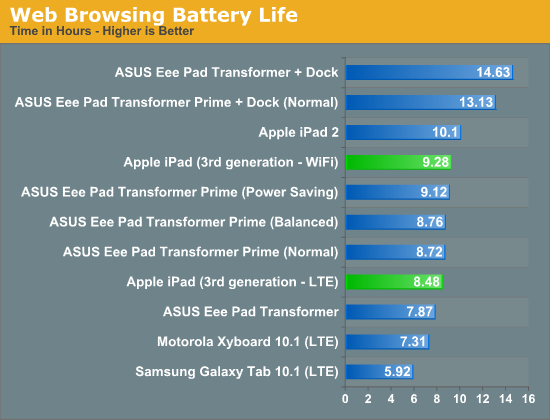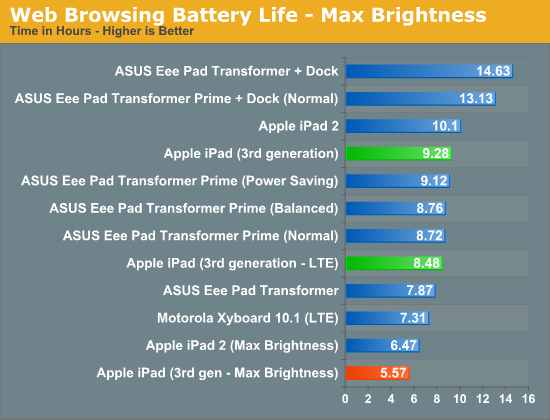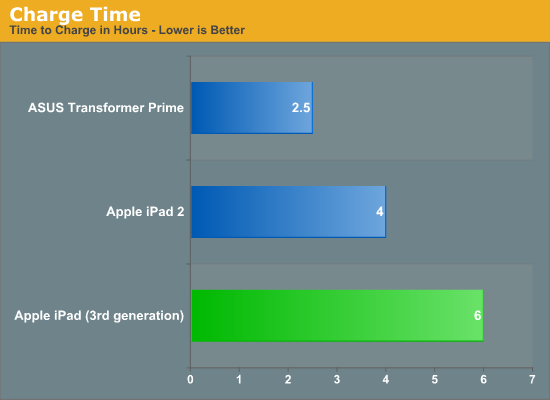The Apple iPad Review (2012)
by Vivek Gowri & Anand Lal Shimpi on March 28, 2012 3:14 PM ESTBattery Life
For a company that has been so laser focused on reducing weight and device thickness, the new iPad actually growing in both of these dimensions was unexpected. From a technical standpoint, the tradeoff makes sense. The new Retina Display consumes significantly more power than its predecessor, as do the A5X and MDM9600 baseband. Both of those ASICs are still built on a 4x-nm LP process and will surely increase power consumption over the iPad 2.
With more transistors switching on the same process node and a display (and backlight) driving more pixels at the same brightness, the battery either had to be larger or battery life would suffer. Apple understandably chose the former and the new iPad ships with a 42.5Wh battery—the largest we've ever seen used in an ARM tablet. The new iPad's battery is so large it's even bigger than what Apple uses in the 11-inch MacBook Air, and it's within striking distance of the 50Wh unit you'll find in the 13-inch model. I do believe this move says a lot about how Apple sees the iPad moving up in the world, but I'll get to a discussion about that later.
With a 70% larger battery than the iPad 2 but with more power hungry components inside, how does the new iPad fare in real world usage? Subjectively: it doesn't last as long as its predecessor. Objectively, our numbers seem to agree.
Our web browsing battery life test browses through dozens of web pages, pausing on each to simulate reading time, until the battery is depleted. All of our tests are run at the same brightness settings (200 nits) to ensure we are comparing apples to apples.

On WiFi we measured an 8% decrease in battery life compared to the iPad 2—nothing huge but not insignificant either. Fall off of WiFi and depend on LTE and you'll see around a 9% decrease in battery life, again—noticeable but not unusable.
I also threw in numbers from the Motorola Xyboard 10.1, an LTE enabled Android tablet running 3.2. Equipped with a much smaller battery (~26Wh), the Xyboard 10.1 delivered 7.31 hours in our LTE web browsing test. The new iPad managed to last 16% longer on a single charge—a smaller advantage than you'd expect given the 70% increase in battery capacity, showing just how much power the new Retina Display and its backlight consume.
The iPad is more than usable on long flights or throughout the day without being tethered to a wall outlet, but in practice you can expect a decrease in battery life compared to last year's model.
Keep in mind that these values are all at 200 nits (roughly 70% brightness on the iPad). If you use the iPad at max brightness (~400 nits) you'll see considerably lower numbers:

In our web browsing test, at max brightness, we saw 5 hours and 34 minutes of continuous use before the battery died. The iPad 2 incurs a similar penalty, lasting under 7 hours in the same test. Do keep this in mind if you need to get a lot of untethered use out of the new iPad. In order to come close to Apple's battery life estimates you'll have to be below 70% brightness.
Charging
Despite the significant increase in battery capacity, Apple continues to ship the new iPad with the same 10W USB power adapter as the previous two models. You can charge the iPad via a Mac/PC USB port that implements the USB charging spec, however doing so will take a minor eternity to fully charge the tablet. Just as before, the new iPad will not charge off of a USB port if the tablet is awake; it will only charge when locked/asleep. The convenience of having a USB based charger is evident, but you'll want to stick with the 10W adapter to actually charge the iPad.
Charging the larger battery does take longer. If we measure from a completely dead state to when the iPad indicates that it's fully charged the increase in time is approximately 50%, from 4 hours with the iPad 2 to 6 hours with the new iPad. ASUS' Transformer Prime, by comparison, requires only 2.5 hours as it ships with an 18W charger. And no, you can't use ASUS' charger to speed up charge times on the new iPad—when connected, the TF Prime charger will only supply 9W to the iPad.

The story doesn't end there however. While the iPad 2 will draw 0W after its 4 hour charge cycle is complete, the new iPad will continue to draw around 3W after it claims to be fully charged. This will continue for roughly another hour at which point the power adapter will draw anywhere from 0.1—0.6W.
Note that when running at full brightness and with a heavy GPU load (e.g. Infinity Blade 2), the power adapter can't supply enough to keep the iPad charged and drive the display/internal components.
There's no good solution here other than for Apple to start shipping the iPad with a higher wattage power adapter. I do believe faster charge times are going to be necessary if Apple is keen on sticking with this larger battery, not to mention the usage issues of not being able to maintain charge equilibrium under load.
Thermals
The increase in power consumption of the new iPad also manifests in the form of increased heat production. A 163mm^2 SoC built on a 45nm LP process is a serious chip. Although it doesn't run hot enough to require active cooling, the SoC alone is responsible for a couple of watts of the iPad's TDP under heavy load. Combine that with a 45nm LTE modem and the heat put off by the more powerful backlight and you've got a recipe for a noticeably warmer device.
Does the new iPad get warmer than the previous one? Absolutely. I would even go as far as to say that it can get uncomfortably warm, but it never gets too hot to hold. If you've used any of the modern Mac notebooks, I don't believe it's anywhere near as bad.
When holding the new iPad in portrait mode, with the home button at the bottom, the lower left corner of the device ends up being the warmest. Along the left edge of the iPad is where the logic board resides, and the lower half is home to the A5X SoC. Under load, particularly a heavy GPU load (e.g. playing a 3D game), this area is going to heat up quickly.
I took several measurements using a contactless IR thermometer in the same ambient conditions on a new iPad vs. the iPad 2. The results are below:
| Thermal Comparison (Max Temperature) | |||||
| iPad 2 | iPad (3rd generation) | ||||
| Web Browsing (2 hours) | 32.7˚C | 37.6˚C | |||
| Infinity Blade 2 (1 hour) | 34.2˚C | 41.9˚C | |||
Again, I don't believe this is a deal breaker but it's the obvious result of remaining on Samsung's 45nm LP process combined with a more power hungry display/backlight. I suspect there will be improvements in efficiency on the display side over time, but I can't see the Retina Display being any lower power than the iPad 2's 1024 x 768 screen. The real avenue for improvement will be when Apple shifts to 28/32nm silicon for the SoC and LTE modem. If you want a cooler running iPad, you'll have to wait until next year for that.










234 Comments
View All Comments
seanleeforever - Thursday, March 29, 2012 - link
Correction: YOU won't buy it doesn't mean the rest of us won't buy it.PS3/XBOX came out in 2005, or about 7 years now. i have no issues buying the latest game and still play.
what phone or pad did you have 7 years ago? oh, you have nothing... heck, the phones/pads you bought 3 years ago probably wont' be able to run today's game.
tipoo - Wednesday, March 28, 2012 - link
Tegra Zone enhancements, the article mentions that.PeteH - Wednesday, March 28, 2012 - link
What mechanism is being used to upscale legacy (1024x768) apps? Pixel doubling? Bi-cubic? Bi-linear? Something else?Guspaz - Wednesday, March 28, 2012 - link
At the most basic level, pixel doubling. However, text that is rendered through iOS gets a free resolution boost so long as the app was compiled with the latest version of xcode. It's pretty common on the iPad 3 to see apps where the interface elements are low-res, but all the text is high-res. And in apps that are predominantly text (like an SSH client, for example), that's all that really matters. Who cares if the triangle picture on a button isn't high res?For stuff like games, that stuff is just pixel doubled.
PeteH - Wednesday, March 28, 2012 - link
I'm not saying you're wrong, but how do you know games (for example) utilize pixel doubling?Guspaz - Wednesday, March 28, 2012 - link
I know because I can look at a game that doesn't support the new screen (such as Plants vs Zombies HD) on my iPad 3 and see that it's using pixel doubling? It does the same for iPhone apps when you use the 2x zoom option. One thing I have not tried is an old 320x480 iPhone app. I'm curious, since that would require 4x zoom.Newer games may choose to render at a lower resolution and then upscale using some sort of filter (perhaps even on the GPU), but at that point they are specifically targeting the new display. An older game that is completely oblivious to the newer display is scaled by the OS using pixel doubling without any interaction from the game.
Steelbom - Thursday, March 29, 2012 - link
Actually, when using iPhone apps, the iPad uses the 640x960 version rather than the 320x480 version, if available.mosu - Wednesday, March 28, 2012 - link
A person in his 50's doesn't care about 300dpi res because he only sees 200dpi, so retina display is just for kids? I really don't get why Apple did not use a standard res panel like 1920x 1200 if they wanted a greater quality image.It means they're stuck with a single form factor?PeteH - Wednesday, March 28, 2012 - link
It's much easier to stick with a single aspect ratio, especially for the developers. Your app looks the same on every device (albeit sharper on higher DPI displays), no need to tweak things for multiple aspect ratios.Sabresiberian - Thursday, March 29, 2012 - link
Umm, where do you get this idea?Generalized statements about vision limitations in humans are usually taken out of context, at best.
;)